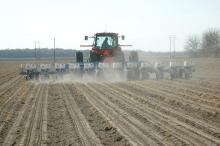Information Possibly Outdated
The information presented on this page was originally released on April 1, 2010. It may not be outdated, but please search our site for more current information. If you plan to quote or reference this information in a publication, please check with the Extension specialist or author before proceeding.
Forecasters predict cotton acreage boost
By Linda Breazeale
MSU Ag Communications
MISSISSIPPI STATE -- Cotton will not be returning to the throne in Mississippi, but growers are slightly more enthusiastic about this former king than they have been in recent years.
The U.S. Department of Agriculture released its annual prospective plantings report March 31, and Mississippi producers are predicted to plant 340,000 acres of cotton. That is an increase of 11 percent from 2009 but is a far cry from the 1.2 million acres planted in 2005 and 2006.
John Michael Riley, agricultural economist with Mississippi State University’s Extension Service, said all of the state’s summer crops are predicted either to increase or to remain constant in total acreage. The source of those additional acres remains a mystery.
“Usually, if a crop has an acreage increase, another crop will have a decrease. That’s not predicted this year,” he said. “Cotton, corn and rice will have a combined increase of 130,000 acres. Soybeans will remain the same as last year, at 2.1 million acres.”
The USDA report is predicting 800,000 acres of corn and 270,000 acres of rice, both 10 percent increases from 2009. Some of the additional acres for summer crops could come from winter wheat, which had significantly fewer acres during the 2008-09 season and again in the current season.
Trey Koger, soybean specialist at MSU’s Delta Research and Extension Center in Stoneville, said he expects some of the acreage increases to come from soybeans as well as wheat, depending on how the weather helps other crop plantings.
Interest in soybeans is not as high as it was last spring, when prices were at the $15-per-bushel level. Currently, prices are about $9.18 to $9.50 per bushel. Cotton prices, on the other hand, are showing promise for 2010.
“Cotton prices have improved just in time to help growers who are ready to rotate from other crops,” said Darrin Dodds, Extension cotton specialist. “Planting cotton behind corn is a good agricultural practice.”
Dodds said decreases in cotton acreage have hurt ginning businesses but is hopeful gins that survived acreage reductions the past three years will continue to operate now that acreage is increasing.
“We did not see as big of an acreage drop in 2009 as we did in 2007 and 2008 simply due to acres being so low already,” he said. “Hopefully, we have bottomed out with our acreage decreases and will begin increasing acreage to reach a point of stability.”
Extension grain crops specialist Erick Larson said he expects corn acreage to remain stable in 2010.
“Planting decisions are often influenced by the crop’s performance the previous year,” Larson said. “In 2009, corn was looking below average and the other crops were looking excellent until all the fall rains started. Those potentially good crops took such a hard hit from the rains that corn yields did not look quite so bad. Growers were able to harvest much of the corn before the rain damage.”
Weather conditions the last week of March and first of April have helped provide farmers, mostly in the Delta, with opportunities to prepare fields and begin planting. Most fields in the northern part of the state remain too wet for significant field work.
“Good planting conditions will help growers plant the expected acreage increase of corn. If we have planting delays, farmers will switch some of those fields to later-planted crops,” Larson said.







